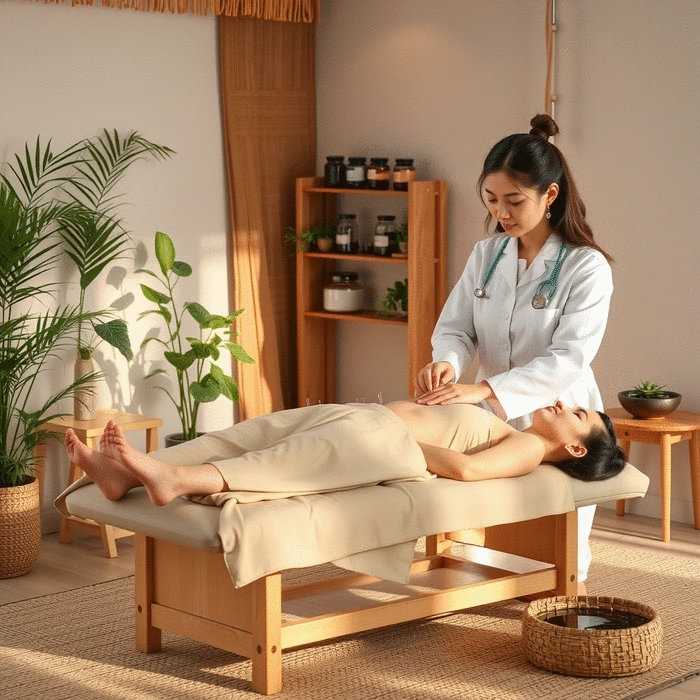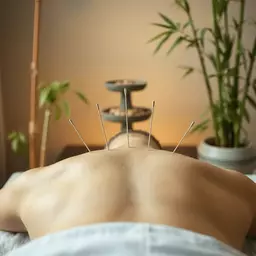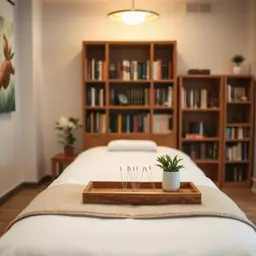Acupuncture in Thailand
Often combined with traditional Thai massage techniques.
Subscribe to get the latest insights and updates straight to your inbox.
Posted on: 2025-09-14
By: Kaiya Whitmore
How does culture shape the way we heal? In Southeast Asia, acupuncture is more than just a treatment; it embodies the community's identity and beliefs. Understanding these unique modalities can illuminate the broader impact of acupuncture on health and wellness.
Acupuncture practices across Southeast Asia reveal interesting adaptations of Traditional Chinese Medicine (TCM), showcasing the influence of local culture and traditions. For a deeper dive into the foundational principles, consider understanding acupuncture and Chinese medicine.
Often combined with traditional Thai massage techniques.
Integrates local herbal remedies, showcasing the role of jamu.
Utilizes local diagnostic methods, creating a unique blend of techniques.
Practitioners tailor treatments based on individual needs, highlighting flexibility.
Acupuncture has a rich tapestry of practices across Southeast Asia, deeply woven into the cultural fabric of each nation. This region showcases a variety of acupuncture modalities that are influenced by local traditions, beliefs, and healing concepts. As I explore these unique practices, I am continually amazed by how acupuncture has adapted to different environments, merging ancient wisdom with modern wellness.
Have you ever considered how culture shapes healthcare? In Southeast Asia, acupuncture is not just a treatment; it is a significant part of community life and identity. By understanding these cultural nuances, we can appreciate the profound impact acupuncture has on individuals and societies alike.
The journey of acupuncture in Southeast Asia is fascinating! Historically, acupuncture was introduced through trade and cultural exchange, evolving into distinct forms that resonate with local populations. This rich history amplifies the ways acupuncture is viewed and practiced, demonstrating that healing is as much about connection as it is about technique.
In many Southeast Asian countries, acupuncture is interwoven with spiritual beliefs and traditional medicine. For instance, in Malaysia, traditional healing practices often incorporate elements of animism, where practitioners believe that health is influenced by spiritual forces. This cultural significance makes acupuncture a holistic therapy that goes beyond physical symptoms. To learn more about this, explore cultural perspectives on acupuncture practices.
Acupuncture's history in Southeast Asia can be traced back to ancient trade routes that facilitated the exchange of ideas and practices. The influence of Chinese medicine is evident, but local adaptations have created a distinctive identity for acupuncture in the region. Each country, from Indonesia to Thailand, showcases a unique blend of historical practices, making the study of these differences so intriguing!
For example, the incorporation of local herbs and massage techniques into acupuncture reflects the region's diverse medicinal approaches. These adaptations have enriched the practice and offer an inspiring perspective on how ancient healing methods can thrive and evolve.
In many Southeast Asian cultures, acupuncture is viewed as part of a broader system of traditional medicine. This framework often includes herbal medicine, dietary practices, and physical therapies. Understanding these interconnected systems is vital for anyone looking to explore acupuncture's full potential.
The integration of acupuncture with traditional medicine also emphasizes the importance of holistic care. Practitioners often assess not just the symptoms but the overall balance of energy, or *qi*, within the body. This comprehensive approach aligns closely with the mission of Acupuncture Perspectives, where we aim to promote awareness of the holistic benefits of acupuncture.
As we delve deeper into acupuncture practices in Southeast Asia, it's essential to highlight the primary features of Traditional Chinese Medicine (TCM) that form the backbone of many local practices. TCM principles, including concepts of yin and yang and the five elements, influence how practitioners diagnose and treat illnesses across the region.
What’s fascinating is how these core concepts have been adapted to fit into the local contexts of different countries. Let’s take a closer look at some of the adaptations that have emerged in the ASEAN region!
Across Southeast Asia, different countries have put their spin on TCM, resulting in diverse practices that reflect local cultures. For instance, in Indonesia, the *jamu* herbal remedy system is often used alongside acupuncture, demonstrating how local wisdom complements traditional practices. This blending of therapies not only enhances efficacy but also resonates with patients seeking familiar remedies. Delve into insights on acupuncture benefits to see the broader impact.
Additionally, Malaysia’s integration of acupuncture with traditional Malay healing practices highlights the flexibility of TCM. Practitioners often tailor treatments based on individual needs, making the process feel personalized and caring. It’s this flexibility that continues to attract people to acupuncture as a viable healing modality!
The role of *jamu* in Indonesia is a striking example of how local herbal practices enhance acupuncture treatment. Jamu, a traditional herbal medicine, is often used to support the body’s healing during acupuncture sessions. This integration underscores the importance of using local resources in traditional healing practices.
By incorporating *jamu* into their treatments, practitioners not only address underlying health issues but also promote overall wellness. This approach aligns beautifully with the mission of Acupuncture Perspectives, highlighting how ancient wisdom can seamlessly merge with contemporary health practices. Isn’t it fascinating how cultures can harmonize traditional therapies?
Diagnosing illnesses within the framework of TCM greatly influences local acupuncture practices. Practitioners often use pulse and tongue diagnosis to identify imbalances in patients. This deep-rooted tradition not only provides insights into a patient's health but also allows for a tailored treatment approach that is crucial for effective healing.
In many Southeast Asian countries, local diagnostic methods may also vary, reflecting cultural attitudes toward health and wellness. Understanding these differences is essential for practitioners and patients alike, as they contribute to a more holistic view of acupuncture and its application in everyday life.
Here's a brief recap of the key points discussed so far:
As we explore the intricate world of acupuncture practices in Southeast Asia, it's essential to recognize how these traditional methods can harmoniously blend with contemporary healthcare systems. This integration not only preserves cultural heritage but also enhances the therapeutic potential of acupuncture, making it accessible to a broader audience. By understanding these unique practices, we can appreciate their significance and relevance in today's health landscape.
One of the primary therapeutic differences between Asian and Western approaches lies in their philosophies. While Western medicine often focuses on treating symptoms, traditional Asian practices, including acupuncture, emphasize restoring balance and harmony within the body. This holistic perspective can lead to profound healing experiences, showcasing the need for greater collaboration between these two worlds.
The effectiveness of acupuncture extends beyond the needles themselves; it is deeply intertwined with cultural contexts and traditions. Each region in Southeast Asia has its unique stories and methods, which shape the way treatments are perceived and administered. By embracing these cultural aspects, practitioners can enhance the overall healing experience for their patients.
Community involvement plays a significant role in promoting awareness and appreciation for these healing arts. Educational initiatives can help inform individuals about the benefits of acupuncture and its traditional roots. In my experience at Acupuncture Perspectives, I've seen how cultural workshops foster a sense of belonging and encourage personal health journeys.
Diving deeper into the rich tapestry of acupuncture, we find that Southeast Asia is just one piece of a larger puzzle. Countries like Vietnam, Japan, and Korea have developed their distinct approaches to acupuncture and healing. These variations offer valuable insights into how culture influences treatment methods. For example, you can learn more about Japanese acupuncture techniques explained.
For instance, Vietnamese acupuncture techniques often incorporate local herbs and specific diagnostic approaches that reflect the region's cultural beliefs. Similarly, the influence of Japanese acupuncture is notable for its gentler techniques and emphasis on patient comfort. Additionally, Korean medicine presents a unique perspective on acupuncture, blending it with concepts of holistic health. Exploring these modalities can enhance our understanding of acupuncture's versatility.
Here is a quick recap of the important points discussed in the article:

 Acupuncture, an ancient practice with roots in Traditional Chinese Medicine, has transcended cultura
Acupuncture, an ancient practice with roots in Traditional Chinese Medicine, has transcended cultura
 As the demand for alternative therapies grows, the need for well-trained acupuncturists becomes para
As the demand for alternative therapies grows, the need for well-trained acupuncturists becomes para
 As global health trends evolve, ancient practices like acupuncture are finding their place in modern
As global health trends evolve, ancient practices like acupuncture are finding their place in modern